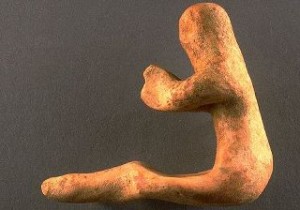
Literary Sources: The Vedas
Our discussion so far is based mainly on archaeological and scientific discoveries. But a more extensive source of information for understanding ancient India are the literary sources like the Vedas. We will discuss this ancient sacred literature of India in greater detail in our subsequent chapters. Here, in this section, we will take a bird’s eye-view of some of the apparent facts of the vedic literature as it appears to an ordinary view with no deep insight, and see what it tells us about ancient India. We use the term Vedas or vedic literature to include the four Vedas, Brahmanas and the Upanishads.
The first impression we get when we take a sweeping view of vedic literature is that like all ancient civilizations, religion dominates the life of the people. When we look at the outer forms of religion, we find ritualistic sacrifice—by pouring oblations into the fire, with a belief that it is carried by the fire to the gods—seems to the main practice. When we look at the religious thought of the Vedas we find a bewildering range from what appears to be a primitive, nature worshipping and polytheistic religion of the early vedism to the most spiritually advanced religion of the later Upanishads. However even in the early vedic religion which in its outer form seems to be predominantly naturalistic or ritualistic, praying for mundane objects like cows and horses, we find sometimes sublime and beautiful verses which express deep and profound spiritual thoughts or lofty monism. We give here below a few verses from the vedic literature to show the apparent range of vedic religious thought:
“Give us treasure of cattle, or heroes, O Dawn, treasure of horses that nourishes many. Make not our altar grass a reproach among men, O Gods, protect us with blessings.” (Rig Veda).
“Heaven and Earth bow before Him, the mountains are in fear of His might, who is known as the soma-drinker, with thunderbolt on his arms, He, O, men, is Indra.” (Rig Veda)
“Varuna spread abroad the air through the forests, he put speed in horses, milk in cows, intellect in the heart, Agni in the waters, the Sun in the sky, Soma in the mountain.” (Rig Veda)
“The Universal Being (the purusha) has infinite heads, unnumbered eyes, and unnumbered feet . Enveloping the universe on every side, He exists transcending it…..From a part of Him was born the body of the universe. Out of it were born the gods, the earth, and men.” (Rig Veda)
“That which exists is the One, sages call it variously.” (Rig Veda)
“That moves and That moves not; That is far and the same is near; That is within all this and That also is outside all that.” (Isha Upanishad)
“But he who sees everywhere the self in all existences and all existences in the self, shrink not therefore from ought.” (Isha Upanished)
What is the process by which this progress took place from a seemingly primitive religion of the early vedism to sublime spirituality of the Upanishad? Is it a gradual spiritual progression? Or is the Upanishadic religion, as most western scholars believed, an abrupt revolt or departure from the primitive and ritualistic religion of early vedism or else as Sri Aurobindo suggests, it is only a restatement and recovery of a spiritual knowledge which was already present in early vedism, but concealed behind symbols of outer life and nature? These are important question for understanding the deeper truth of Indian civilization.
When we come to the geographical and social condition of the Vedic age, the Vedic literature talks about several rivers and two oceans, cows, horses and cattle, towns and cities, kings and wars, merchants and trade and a fourfold social order. In Rig Veda there were constant references to conflict between Aryans who are the favorites of the gods and Dasyus and the various forms of demons. The gods, especially Indra was frequently invoked by the Aryans for help and protection against their enemies, Dasyus and demons. Dasyus were sometimes described as dark and stub-nosed. This has given birth to speculations amongst scholars, especially aryan invasion theorists, that the Dasyus were perhaps the dark-skinned Dravidians. But there are many verses in the Rig Vedas in which Dasyus are described as ‘noseless’, ‘handless’ and ‘footless’ which makes us wonder whether Dasyus are human being or denizens of another world.
All these references in the Vedas may help us to have some image of the economic, social and political life and geography of ancient India. However, If the early vedism turns out to be what Sri Aurobindo has suggested, and these antique vedic hymns are the expressions of the spiritual experience and discoveries of the vedic seers, expressed in the symbols of outer life, then all the objects, events, and beings described in the vedic hymns acquire a deeper symbolic and spiritual significance.
When we pass from the early vedic to the later Upanishadic age, as described in the Upanishads, we find a remarkable civilization in which people from every section of the society—lowly outcastes, kings, merchants, ascetics—seeking for the highest truth of the spirit. If this great spiritual efflorescence of the Upanishad is not a sudden growth unrelated to the past but only a recovery or rekindling of the spiritual knowledge inherent in the earlier age, then the beginnings of Indian civilization points out to a unique civilization and culture which has a special, or natural and inborn affinity to religion and spirituality.





